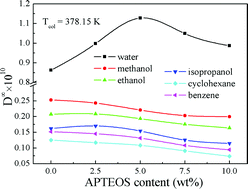Novel hybrid materials were prepared through sol–gel reaction of poly(vinyl alcohol) (PVA) and γ-aminopropyltriethoxysilane (APTEOS). Solubility and diffusion behavior of a series of solvents in the PVA/APTEOS hybrid materials were studied by inverse gas chromatography (IGC) fitted with a packed column. Solubility thermodynamics parameters at infinite dilution, such as the activity coefficient Ω∞1 and the solubility coefficient S of solvents in the hybrid materials, the partial molar excess free energy of mixture ΔGm, and the Flory–Huggins interaction parameter χ∞12 were determined. The infinite dilution diffusion coefficients D∞ of the solvents in the hybrid materials were also calculated. Effects of APTEOS content in the stationary phase and the column temperature on the solubility and diffusion of solvents in the hybrid materials were investigated. The hybrid material containing 5.0 wt% APTEOS has the strongest interaction with water, the largest S and D∞ for water, and the hybrid material has a promising application in membrane separation, such as pervaporation dehydration of alcohol solution. The solubility parameter δ2 of the hybrid materials was estimated, and it decreased with increasing APTEOS content. The dependence of D∞ on temperature was in good agreement with the Arrhenius equation.

You have access to this article
 Please wait while we load your content...
Something went wrong. Try again?
Please wait while we load your content...
Something went wrong. Try again?


 Please wait while we load your content...
Please wait while we load your content...